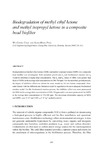Mostrar o rexistro simple do ítem
Biodegradation of methyl ethyl ketone and methyl isopropyl ketone in a composite bead biofilter
| dc.contributor.author | Chan, Wu-Chung | es_ES |
| dc.contributor.author | Peng, Kang-Hong | es_ES |
| dc.date.accessioned | 2014-10-01T10:16:58Z | |
| dc.date.available | 2014-10-01T10:16:58Z | |
| dc.date.issued | 2007 | es_ES |
| dc.identifier.citation | Biotechniques for Air Pollution Control II, 2007: 405-413. ISBN: 978-84-9749-258-4 | es_ES |
| dc.identifier.isbn | 978-84-9749-258-4 | es_ES |
| dc.identifier.uri | http://hdl.handle.net/2183/12835 | |
| dc.description.abstract | [Abstract] Biodegradation of methyl ethyl ketone (MEK) and methyl isopropyl ketone (MIPK) in a composite bead biofilter was investigated. Both microbial growth rate kg and biochemical reaction rate kd would be inhibited at higher inlet concentration. The kg and kd values of MEK were greater than those of MIPK in the average inlet concentration of 100-300 ppm. For the microbial growth process, the degree of inhibitive effect was almost the same sensitivity for two ketone compounds. Zeroorder kinetic with the diffusion rate limitation could be regarded as the most adequate biochemical reaction model. For the biochemical reaction process, the inhibitive effect was more pronounced for MEK in the average inlet concentration of 100-150 ppm and it was more pronounced for MIPK in the average inlet concentration of 150-300 ppm. The maximum elimination capacity of MEK and MIPK were 0.127 and 0.101 g-C h-1 kg-1 packed material. | es_ES |
| dc.language.iso | eng | es_ES |
| dc.publisher | Universidade da Coruña | es_ES |
| dc.title | Biodegradation of methyl ethyl ketone and methyl isopropyl ketone in a composite bead biofilter | es_ES |
| dc.type | info:eu-repo/semantics/conferenceObject | es_ES |
| dc.rights.access | info:eu-repo/semantics/openAccess | es_ES |






